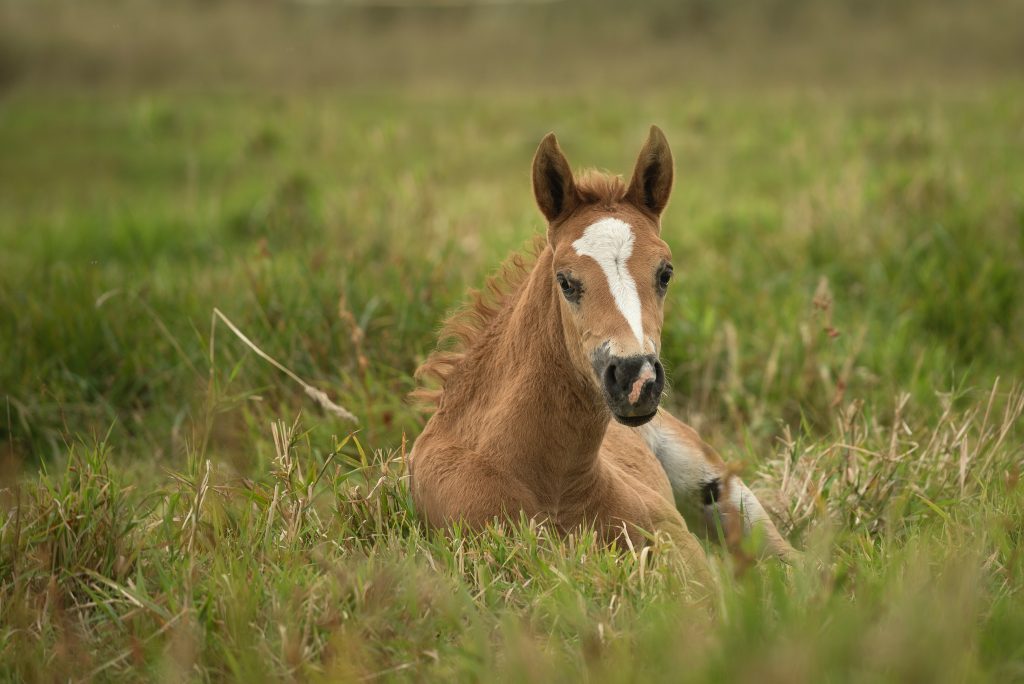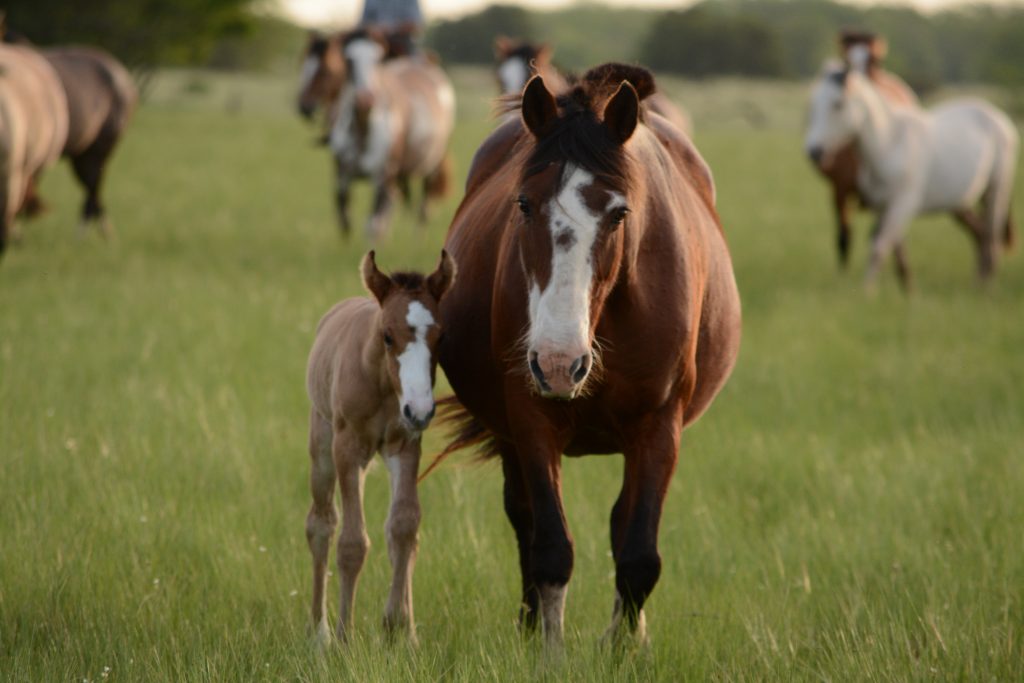Your mare is just days away from delivery.
As the big day approaches, it’s understandable that you’re feeling a little on edge. A newborn foal is nothing short of a miracle, but a successful birth is just the tip of the iceberg. It’s the first 48 hours of your foal’s young life that are most pivotal.
Below, we’ve put together a timetable of the first 48-hours to ensure your little one is right on track. Keep in mind these are guidelines only. Your gut instinct, even if all seems well, is never something you should ignore. Your veterinarian is always there to offer the best advice and newborn care. Never hesitate to call her.
Birth to 3 hours
During the first few minutes after delivery, your mare will take a moment to catch her breath. Her newborn foal will probably remain in a recumbent position at first but should begin lifting his head and begin breathing on his own within seconds after birth. In a normal delivery, the foal is covered by a white glistening membrane called the amnion. The amnion will typically rupture during birth, but if this hasn’t happened, you’ll need to gently open and remove it from your newborn foal’s nose. View our birthing stall from RAMM Fence.
Your foal’s first few breaths may sound a little waterlogged; no worries. While in utero, your foal’s lungs were filled with fluid. Most of this fluid will be absorbed into his tissues, but a little moist rattle is perfectly normal. Measure your foal’s respiratory rate by counting his breaths for fifteen seconds and multiplying that number by four. His initial respiratory rate should fall somewhere in the range of 75 breaths per minute. This will slow to 50 breaths per minute within an hour after birth and then finally to 34 bpm within 12 hours.
Expect your little one to rest and gain his bearings before trying to position himself into a sternal recumbent position. Your foal will be wobbly, but on his feet, within thirty minutes or so of birth. He should suckle within two hours. Delayed nursing is a serious problem. In the early hours after birth, your mare produces milk known as colostrum, a thick, yellow, and sticky milk full of immunoglobulins that are absorbed through your foal’s gastrointestinal tract in the first 24 hours of life. Call your veterinarian immediately if your foal fails to nurse.
The newborn foal has a normal heart rate of between 40-80 beats per minute, though this can rise to as high as 150 bpm as he struggles to get to his feet. Those first few wobbly moments are like running a marathon for the little guy!
Immediately after birth, the umbilical cord is still intact and pulsing. When the mare stands or the foal attempts to rise, the umbilical cord should naturally separate. Allow the umbilical cord to remain attached for the first few minutes of the foal’s life to ensure adequate blood flow from the placenta to the foal’s circulatory system. If it doesn’t separate on its own, carefully twist and pull the cord apart. Never cut the cord. Instead, hold the cord firm on either side of the break site (approximately two inches from the foal’s body) and twist and pull to separate.
The cord should be monitored for abnormalities. Hemorrhage, urine leakage, or swelling are all warning signs. Disinfect the stump with a chlorhexidine solution, not iodine. Studies show chlorhexidine reduces bacteria without causing tissue damage. Your mare will expel her placenta within one to three hours. It’s best to save this in a bucket for your veterinarian to inspect.

3 to 12 hours
By the three to four hour mark your foal will have nursed, lied down, and gotten back to his feet several times. He’ll expel his first bowel movement in the first 12-48 hours, which presents initially as meconium.
Meconium is dark brown to black in color, with a consistency ranging from paste to firm pellets. The stool will change from this dark color to a lighter brown and softer consistency with the intake of milk. If your foal is posturing, but having trouble expelling stool, call your veterinarian immediately.
Your foal’s first well visit should occur within the first day of life. A thorough physical exam of the foal includes assessment of alertness and behavior, ability to rise, coordination and strength, and desire and willingness to nurse. Your veterinarian will check the foal’s maturity, his neurologic signs, cardiovascular well-being, and his respiratory system. Your vet will also check for the passage of meconium and manure, urination, musculoskeletal conformation and use, ophthalmic function, and the health of the umbilical cord.
12-24 hours
During the next 12-24 hours, the foal’s stool color will change to a milky brown. He should stand, appear curious about his surroundings, lie down, sleep, and nurse about every 20 minutes or so. When he’s up, he’ll begin to get more active and playful. If it is necessary to restrain your foal for evaluation or imprinting, do so carefully. Correct restraint of newborn and young foals is performed by holding them around the chest and hindquarters. Never restrain a foal by holding them around their neck as this can cause accidental damage to the trachea.

24-48 hours
Reduce your checks to 4 hour checks if all is going well. Monitor stool, your mare’s udder, and the overall curiosity and well-being of your foal. If the mare and foal are healthy and the weather is cooperative, the pair can be turned out. Keep them separate from other adult horses, even mare and foal pairs, for the first week of life until there’s a well-established bond between mare and foal. This also allows your foal to get a little steadier on his feet.
Monitor your foal for changes in behavior or physical well-being. All changes should be noted and reported to your veterinarian. Call your veterinarian immediately if you notice diarrhea, listlessness, a change in nursing pattern, changes in body temperature, respiratory rate, or heart rate.
Finally, don’t forget to take photos and be sure to share them with us here at the Your Horse Farm blog. We’d love to hear your stories and tips for caring for the little ones!




joker123
It’s hard to come by experienced people about this topic,
but you seem like you know what you’re talking about!
Thanks
vivo slot
Howdy! This is my 1st comment here so I just wanted to give a quick shout out and say I genuinely enjoy reading your articles.
Can you suggest any other blogs/websites/forums that go over
the same subjects? Thanks for your time!